|
Brazil's most famous and visited city was originally named by a Portuguese explorer, who mistook the large bay for a river and named the city "January River" or Rio De Janeiro in Portuguese. These days, the locals have coined a new name for the city and while it's not official, it is certainly well deserved - Cidade Maravilhosa or "Marvellous City". The more information we read about Rio De Janeiro in the lead up to our trip, the more dubious and safety conscious we became. There are a lot of horror stories about petty crimes, kidnappings and muggings in Rio and in the lead up to the FIFA World Cup the media had a field day questioning the city's readiness and general safety for visiting tourists. We had decided early on in this trip to fly in to Rio De Janeiro from Iguazu Falls to save ourselves from another long haul bus trip, but also to avoid rushing to be there in time for the opening night of the World Cup. While this was a good idea in theory, after booking the flight, we read countless reviews of how dangerous Rio airports are and how "express kidnappings" are a real threat. This is where tourists find themselves jumping in a taxi but instead of being taken to their destination, they are taken to a random town or favela where they are told to withdraw all their money from an ATM and then dumped afterwards with no money and sometimes also no luggage. So with this information in mind, we left our accommodation in Iguazu feeling like members of the Bali Nine. We had every important document and the majority of our money strapped to our bodies in some rather interesting and (if I may say so myself) creative ways! We arrived at Rio airport and collected our luggage without an issue. We went to the official taxi stand and paid a hugely inflated price for an authorised taxi, again, without an issue. Then we jumped in our taxi with a friendly driver who made some basic English/Portuguese conversation with us and before we knew it, we arrived at our awesome apartment on Copacabana Beach. We couldn't believe our luck. We had been in Rio for almost 2 hours and so far hadn't been mugged, kidnapped or pick pocketed! How crazy! As it turned out, our experience on that first day was just the start of an incredible 10 days in Rio! 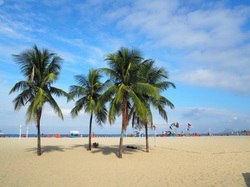 Photo: Copacabana Beach, eerily quiet but stunning as always, before the madness of the World Cup began! We had booked an apartment 10 months in advance through Airbnb and could not have been happier with the apartment, the lovely owner Bruno or the incredible location. We were three streets back from Copacabana Beach and a short 10 minute walk down the beach to the FIFA Fan Fest where every match was screened live on a huge TV screen and there was an incredible beach party with live music everyday. I haven't been to Rio De Janeiro before so I can't comment on the safety or atmosphere of the city before the World Cup, but I can say that I believe Rio had done an incredible job preparing themselves for the World Cup and the vibe in the city throughout our visit was amazing. All day, everyday there were people walking around the streets decked out in their country's colours, blowing kazoo's and singing football chants. I've never seen anything like it! We had the most wonderful week exploring Rio but also had plenty of time to chill out on the beach and watch enough World Cup matches to last me a lifetime! We did the obligatory visit to Christ the Redeemer - and didn't spontaneously combust upon arrival! The drive up is pretty cool, the statue itself is huge and the crowd made us both claustrophobic and angry. It was one of those sights we wanted to cross off our "must do" lists, but the usually hectic crowd was 100 times worse than expected due to the added impact of the World Cup and we were lucky to leave with a single photo without someone else's head, arm, flag or other appendage ruining it!  Photo: Just one example of our incredible photography skills at Christ the Redeemer. Not only did we cut off Jesus' head in our "selfie" efforts but we also have 3 paparazzi in the background! After leaving Hey-Zeus we decided that while we were already doing the tourist thing, we might as well spend the afternoon crossing off another "must-do" from our list and one that I personally, was pretty damn excited about - Sugarloaf Mountain. We took the cable car to the top of the first mountain and already we were snapping away at the incredible views. Sugarloaf is one of those places where you arrive and are immediately blown away by the view. After taking around 100 photos in 5 minutes, you realise that you are actually taking photos from the cable car platform on the lower peak and not even the purpose built viewing area on the higher peak that provides the best views! The second cable car takes you to the second peak which provides one of the most incredible natural viewpoints I have ever experienced in a city. We had planned our trip to coincide with sunset and as the sun dropped behind the mountainous jungle framing the city, the view became more spectacular every minute. We ended up spending over 3 hours wandering aimlessly and fighting over who was going to take the photos of this incredible picture-perfect landscape we found ourselves in! 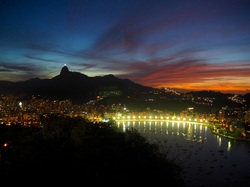 Photo: Sunset from Sugarloaf Mountain Another of our favourite sights in Rio was the beautiful Escadaria Selaron or Selaron's Staircase in Lapa. This work of art was created by a Chilean man living in Rio who went broke multiple times by spending every spare dollar and minute working on turning a simple backstreet concrete staircase in an otherwise average neighbourhood, into a beautiful mosaic. While the tiles were originally scavenged from building sites and some hand painted by Selaron, over the years tourists began sending tiles from all over the world. Today, the stairs are covered in over 2000 tiles from 60 countries around the world (Yes we found multiple Aussie ones including an AC/DC tile. Selaron once said that "This crazy and unique dream will only end on the day of my death". Ironically after 23 years of working on creating this artwork, Selaron was found dead at the base of the stairs in 2013.  Photo: Just one small section of the incredible mosaic staircase Escadaria Selaron So, I suppose by now some of you are wondering about the actual World Cup. Well for Wade and I, being in Brazil during the World Cup was more of a coincidence than actual planning! Of course as soon as we decided to make the trip to South America we applied for tickets (and were lucky enough to get them!) but neither one of us is usually a big soccer/football fan. However all of this changed the day the World Cup started. The atmosphere in Brazil, but in particular in Rio was intoxicating! You could either throw caution to the wind and join in the festivities or you could leave the city (more like the country) to achieve some solace elsewhere. We chose to dive in headfirst and experience all that the city and the World Cup had to offer! The opening match was intense! We were two of ten thousand people packed into the FIFA Fan Fest on Copacabana Beach. It was an overload of colours, music and football chants and within minutes we were covered in sand, beer and sweat.... and loving every minute!  Photo: FIFA Fan Fest opening night Throughout our time in Copacabana we ended up dropping into the Fan Fest at least 5 times, but while every day had a great party vibe, none quite equalled the excitement of the opening match on that first night. We were also lucky to have our mate Sota staying just a few streets from us in Copacabana so there was always a good reason to catch up over a beer and enough Capirinha's to keep the Brazilian economy afloat! Eventually, we figured out that to save a few bucks and enjoy the games from a more relaxed area and less hectic crowd, you could actually sit outside the Fan Fest right near the high tide line and still see the huge TV screen! The crowd was still huge and equally passionate about the matches but rather than standing and swaying in the over-packed arena for 90 minutes (not to mention the half hour beer queues) you could kick back on beach chairs while locals walked up and down the beach selling beer, tasty snacks and ice cold Caipirinha's. Now that's more my style of football! 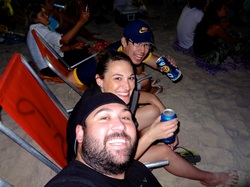 Photo: Hanging outside Fan Fest on the beach with Sota, our mate from Perth, who we also believe many Brazilians mistook for some famous Japanese soccer player! Of course all of these festivities culminated in the event we had been waiting for. The Argentina Vs Bosnia-Herzegovina round one match at Maracaña Stadium. Maracaña Stadium was built in 1950 for the last FIFA World Cup held in Brazil and is the largest stadium in South America so you can only imagine our excitement at our first live football game being in such a historically significant and HUGE stadium. Upon arrival we were greeted by some not-so-friendly looking riot police. While we were definitely expecting an eventful night, we were still surprised to be surrounded by hundreds of armed police, fully kitted up with helmets, riot shields and some hectic looking guns. I had decided early on that I would be cheering for Argentina seeing as we had recently visited there and my Spanish is so awesome that people frequently mistake me for a local...... Hey, I can dream! There were also probably four times as many Argentinian fans so we figured it was a safer bet should any fights break out. The atmosphere in the stadium was breathtaking. The official attendance for the night was just under 75,000 screaming, cheering, diehard fans. Throughout the match I think we saw two people evicted by the security guards, there were three incredible goals scored and Wade only spilt his beer on me twice. Overall, it went off without a hitch! 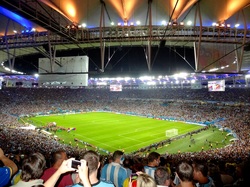 Photo: The full house at Maracaña Stadium, I would have posted the video, but the noise is quite brutal on the old ear drums! While the World Cup was exhilarating, I had an even more adrenalin filled morning ahead of me - Hang gliding from the highest point in the Tijuca Forest down onto Sao Conrado Beach. It was such a unique experience. The take-off and landing are both a fast-paced adrenalin rush, but the flight itself is relaxing and breathtaking. It gave me a sense of freedom I've never felt before. While the cost was a little hard to justify for an 8 minute flight (especially when they pumped up the price just for World Cup), it was 100% worth it and I'd do it again in a heartbeat! After only a few days in Rio, we had started frantically searching for somewhere to stay for a few extra nights so we could turn our seven night stay into ten! We were lucky enough to find an apartment only a few streets from our originally accommodation and while we well and truly blew the budget, we figured this really was a once in a lifetime event.
Eventually, our time in Rio had to come to an end. Our plan from here is to continue heading up the North Eastern coast of Brazil all the way to the Amazon River. This is more or less a distance of some 4700km! With plenty of overnight buses and some more unique modes of transport in the coming weeks, I hope to update you all again soon. In the meantime I'm always keen to hear any comments, suggestions or advice on our trip in general or any blogging tips. As always, the photos here are just a small insight into our "FIFA World Cup" and "Brazil" albums that you can see on our Photo Albums page.
1 Comment
So Iguazu Falls hey. It's been on my bucket list for years now, but it was only once we started researching this trip, that I seriously looked into the logistics of it. I'll keep the geography to a minimum here but having said that, it is a necessary starting point. At the same time, I should probably also mention, that this is my first informative blog (well I'll try to be) rather than the usual this-is-what-we-did-today style, so hopefully this might help anyone planing a trip to Iguazu in the near future! The Iguazu River (Rio Iguazzu in Spanish) forms the border between Brazil and Argentina in South America. While the majority of the Iguazu River is in Brazil, perhaps for border convenience, the point of the river that forms Iguazu Falls is also a brilliant and dramatic meeting point for the two countries. What makes this region even more spectacular is that just a few kilometres down river from the falls, is the "Triple Frontier" where the Iguazu and Parana Rivers converge and more importantly, form a meeting point for the countries of Brazil, Argentina and Paraguay. Each country has erected an obelisk to signify their country and from each obelisk, tourists can view the other two bordering nations. Besides the fact that the overall scene is not entirely attractive, (pretty damn boring if you ask me!) this really is quite a unique view! So, back to where we started. What is the difference between Iguazu and Iguaçu? Well, as we have recently discovered (much to our disgust) while the official language of Argentina is Spanish (which we were getting REALLY good at), unfortunately for us, the official language in Brazil is Portuguese. So considering the river has two banks, each in a different country, the real, black and white difference is the most obvious, the spelling! Ok so having said that, there is so much more beneath the surface. The truth is that Iguazu and Iguacu are actually two completely different locations. Puerto Iguazu is the town nearest to Iguazu National Park in Argentina AND Foz Do Iguaçu is the town closest to Iguaçu National Park in Brazil. There is so much more to these places than a simple difference in language, Visa requirements and a short border crossing! The opposing sides of this incredible region offer a completely different view, opinion and overall experience of this two-in-one UNESCO World Heritage Site. Let's start - as Wade and I did - with Puerto Iguazu, the tourist town providing access to the Argentinian side of Iguazu Falls. Puerto Iguazu in June, is a sleepy town with a few sealed but mainly cobbled or unsealed roads. It has two main streets, each with plenty of souvenir shops and restaurants which eventually become pubs or dance clubs late at night. The rest of the town has a safe, quiet feel to it. The people are friendly, the hotel staff extremely hospitable and compared to our recent destination of Buenos Aires, there are plenty of well-priced and bargain meals to be found around town. The local kiosk will even hand-write a receipt, on a scrap piece of newspaper, for the $5 deposit you paid to take home the local beer that comes in returnable bottles! In all honesty, I can't imagine any foreigner visiting Puerto Iguazu without the main purpose of visiting the Argentinian Iguazu National Park. Thanks to the geography of Iguazu Falls, Argentina has been lucky enough (in my humble opinion) to claim over 70% of the waterfalls that make up the collective Iguazu Falls. The bus trip to the park entrance of Iguazu National Park took around 20 minutes. The drive was reasonably uninteresting and we arrived soon enough at a small, nondescript roundabout. When we stepped off the bus, Wade and I approached a row of ticket windows, when before long, we realised they were completely unstaffed. We somehow led the small crowd of 10 people towards the next section of ticket windows where we purchased our one-day National Park passes. We wandered aimlessly through the barren entry gates and ensuing maze of paths, following the map on the tourist brochure which was completely different to the one sign-posted around the park. When we found ourselves at "Central Station" we were pleasantly surprised that the light rail running from the park entrance to the next two major destinations was not only free, but also provided shelter from the sprinkling rain. On a side note, the train was a nice touch, both for the impact on the environment and also to make the walks accessible to the elderly or anyone with physical impairment. However on our return, we realised it was much quicker to take the walking track through the swampy marsh area and do a bit of wildlife spotting on the way, than it was to wait for the very intermittent train departures. We took the train to the second (and last) stop, known as Gargantua Diablo (the Devils Throat) and the pinnacle of Iguazu Falls. The boardwalk to the Devils Throat is 1.3km across wide rushing rivers and small sections of wildlife filled islands. We were lucky enough to cross one of the boardwalks with a small family of Coati's, the large squirrel cross racoon type animals found in this area! Photo: Coati's crossing the boardwalk towards the Devils Throat in Iguazu National Park Before arriving at the Devils Throat, the thundering sound of the waterfalls fills your imagination with what is ahead of you, however no dreams could possibly prepare you for the sight ahead. The slippery metal boardwalk leads the crowd, quite metaphorically into the Devils Throat of Iguazu Falls. The spray from the falls rises high enough to look like a smoke stack and it is only once you get close enough to feel the water on your face that you realise just what this white mist is. It is 1700 cubic metres of water per second plummeting over a 150m high drop. And that is only on average. Wade and I just happened to be in Iguazu in the middle of a week long downpour. The volume of water was hugely compounded and we were none the wiser! Photo: Standing on the edge of the Devils Throat, the main attraction at Iguazu Falls Upon walking away from the Devils Throat, we thought we'd seen it all. But we had not even seen half of what the Argentinian side of Iguazu had to offer. Islands have been carved out of the landscape from centuries of water gushing through this hard rock. These islands have caused over 150 waterfalls to form with the Devils Throat being the widest and having greatest volume of water flow, but in many ways, it is not the most spectacular. The lower boardwalks weave their way through rainforest past fast flowing rivers which soon become gushing waterfalls. Before long, you have seen enough waterfalls to last a lifetime..... or so you might think. Photo: Just a few shots from the many waterfalls and boardwalks in Iguazu National Park The main attraction of the lower section of Argentina's natural waterpark, is getting within 20m of a thundering wall of water while being completely soaked by the seemingly light mist floating gracefully around you, before you quickly realise you are in fact standing, more or less, in a shower! It's strangely exhilarating! So, by now you MUST be wondering how Brazil could possibly compete with this experience. Well (again, this is only my opinion) in many ways it doesn't, but in others Foz Do Iguaçu National Park in Brazil, wins hands down. (if you can't already tell by now, I'm a pretty good fence sitter!) The bus and border crossing from Argentinian Iguazu to Brazilian Iguaçu takes about half an hour. Essentially all it involves is jumping on a public bus, getting off at the border for customs and immigration checks, then getting on the next bus to continue your journey into town, which is actually only 15km from your original destination! Upon arriving in Foz Do Iguaçu we were first struck by the size of the city. It is over four times the size of it's Argentinian counterpart! We were fairly hesitant disembarking the bus in the pouring rain to find our way around this new city especially seeing we had one extra hurdle to cross, a new language to fumble our way around. It also didn't help that since we arrived in South America, we have heard nothing but horror stories about Brazil and it's crime rate. Even the Australian government recently released a statement saying that if attacked in Brazil, hand over all of your belongings and most importantly "Don't scream". Apparently this just aggravates the offenders - Thanks for the advice Australia! Anyway, we managed to find our hotel easily enough thanks to plenty of research and a roughly sketched mud map prior to leaving Argentina! The only problem throughout this whole procedure in fact was the one thing we came here to witness..... the environment. It has been a long time since I have experienced rain of the magnitude we felt on our first day in Brazil. We made the executive decision to go for a short walk in the pouring rain before retreating to our hotel room like drowned rats for an evening of movies and googling any other possible options for the next day or two while this rain was expected to continue. As it turned out, we were in for two of the heaviest days of rain, thunder and lightning in this area for 2014. We set our alarms early for Monday morning because we had decided that rain, hail or shine we were heading out to see what we had come all this way to see - Parque Nacional Do Iguaçu, Brazil. Luckily, the rain had done it's job and saturated everything in sight and by Monday, we were left with a beautiful, lush green surrounding and a clear blue sky! We caught the local bus from the terminal in Foz Do Iguaçu and half an hour later, we arrived at the gates of the National Park. Our first impression here was totally different to the Argentinian side. The buildings are modern and well maintained, there was a large crowd waiting in line to buy tickets and once we had passed through the gates, we jumped on board a colourful open topped double-decker bus for the 10 minute journey to the start of the actual walking trails. Throughout the bus ride, there's commentary about the park and it's features in Portuguese, Spanish and English. The first thing you notice on this side is that rather than multiple walks of varying distance and environment, Brazilian Iguaçu offers many different paid activities (boat trips, 4wd tours, kayaking and even a helicopter flight) but as far as the walking tracks go, there really is just one path with a few little optional side tracks. This path offers multiple panoramic viewing platforms of the falls, and it is once again an incredible sight but there is only one opportunity to get up close to the falls whereas on the Argentinian side, you walk over, under and practically in the many waterfalls around you. Brazil also doesn't give you an opportunity to see any of the smaller falls like the rainforest walks in Argentina provide. As we began the walking trail, we overheard some fellow travellers conversation and vaguely picked up on the idea that the recent downpour may have changed a few things about our surroundings. Before long, this was in fact, confirmed. The rain had increased the water flow by a third and the incredible waterfall we had seen three days ago, was now an epic, thundering and more importantly, deadly looking force of nature. Due to this, my judgement of the Brazilian side of Iguaçu Falls may be slightly skewed as we missed out on multiple sections of boardwalk that would usually be the closest and most exciting sections of the much shorter, simpler walks that this side offers. Check out the photo below. There are also plenty more on the Photo Albums page of this website.  Photo: The circled sections of this photo are highlighting the lookout points on the lower boardwalk of Brazil's Iguaçu Falls National Park. These lookouts are usually 10-15 metres above the water! For good reason, this entire section of the walk was closed off and we could only view it from the elevated viewing platform some 30m above. It was still quite frightening from there! We thoroughly enjoyed our experiences on both sides of the falls and as I hope you can see from this blog, it's pretty damn hard to say whether one side is "better" than the other when really they are so different. I personally would recommend that visitors to this area, make every effort to visit both sides and make their own judgement, however, if time doesn't permit this, I felt that while the facilities are much better on the Brazilian side, the Argentinian side was far more interesting and gave a much more satisfying experience of the falls. I really hope this blog helps - even just a little - for anyone planning on visiting this incredible natural wonder. It truly is one of those places that cannot be fully described through words or photos. It needs to be experienced. So go on.... Experience it! It's hard to believe that it has only been one week since we left the comfort of Australia and began this crazy journey through South America! Since arriving here last Wednesday, we have already covered over 1500km as we made our way from Santiago, Chile to the wine making region of Mendoza and we now find ourselves in the capital of Argentina, Buenos Aires (you can follow our route on Our Map). I suppose I should start this blog back in Santiago where we left off. Santiago has the potential to be a beautiful city. The people are lovely and the way the snow capped Andes frame the city makes for some truly picturesque views. Sadly due to the geography of the city and the fact that it is grossly over populated, the view is almost impossible to see on most days due to severe pollution. We were lucky in that it rained on our first night in Santiago. For anyone who knows our history with rain, you would know that normally I don't consider it to be very "lucky"! However, when it rains in Santiago, the smog is suppressed for a short period of time and the view from the many hills in the city becomes priceless. We took the funicular - a small train that runs up a 45 degree angle - to the top of Cerro San Cristobal. The view was beautiful as we had made the trip early in the morning after the previous nights rain, but even in the short time we spent there, the smog started to move in as we wandered around the many stairs and walking paths that cover the highest point in Santiago's city. After an intense two days in Santiago, it was time for us to embark on the first of many long distance bus trips we will be taking and also deal with our first border crossing. This eight hour journey covered some of the most incredible scenery we have ever seen. The road weaves up through the Andes where in only a few short weeks, the road may become impassible due to heavy snow. It just so happened that there has not yet been enough snow to affect the roads, making our journey that perfect compromise between snow covered mountains but dry roads. The fact that the bus was like a business class flight also helped the cause, with a meal and snacks being served throughout the trip on our almost fully reclining leather seats! 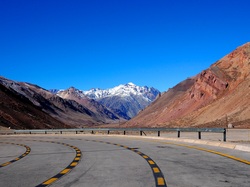 Photo: The view from our bus window. It was much more beautiful than this photo gives it credit for! Crossing the border from Argentina to Chile was much quicker than we had read in some online forums so we were super impressed with the efficiency although somewhat confused with their bag handling procedures. Being a customs/immigration point, X-ray bag checks are necessary before continuing the journey. As the bags are unloaded from the bus, men walk around with a small styrofoam cup shaking it for money. Wade and I stood in awe wondering if this was some sort of trick because if we did this at any Australian airport , I'm pretty sure it would be considered bribery! It turns out that every time someone touches your bag, they expect a tip however it did seem mildly convenient that the non-tippers were also the people whose underwear was soon on display while their bags were searched! After a long journey we arrived in Mendoza, the wine making region of Argentina and one of the top regions in the world for the variety of red wine, "Malbec". We decided there was only one way to mark this occasion so we went out for an all-you-can-eat parrilla (Argentinian BBQ) accompanied by some delicious Malbec. Now I blame the fact that the waiters had us drinking wine out of tumblers rather than wine glasses, but somehow four empty bottles of wine ended up on our table that night..... oh the shame! Luckily we had Sunday to recover from the previous nights festivities - does eating too much meat give you a wicked headache and the urge to hug the porcelain?? On Monday we did the obligatory wine tour around the region, tasted some incredible locally made olive oils and had a delicious lunch of empanadas (small meat pastries), a local dish similar to shepherds pie and a sickly sweet dessert filled with dulche de leche (a local caramel used in just about every dish). We spent the day with a Canadian couple who were the only other English speakers on the tour but also happen to have multiple stops on their journey that will also coincide with ours. Gerry, the dude, is actually going to the same FIFA match as us in Rio so we are hoping to meet up again soon. So after spending a few days wine tasting and strolling the beautiful wide streets and park-like plazas of Mendoza, we caught an overnight bus to Buenos Aires. Tonight we are recovering from the uncomfortable bus-sleep by having a quiet night in our apartment - booked through Airbnb - and enjoying a few beers, a movie and a home cooked meal. We have heaps of sight seeing and touristy activities to do while here in Buenos Aires over the next week so expect an action packed blog next time you hear from us! Make sure you check out our most recent photos in our Argentina photo album!
Buenos Aires did not disappoint! Well for me anyway, it did not disappoint. This week however, we discovered that Wade is not particularly fond of discovering halfway through a days activities, that I may have left out some vital details of exactly what we were doing for the day. Our first example of this was surprisingly enough, when we visited the Evita (aka Eva Peron) Museum. If you've seen the movie you may have some idea who she was, but in short she was the wife of the President of Argentina and while there are always two sides to every story, she is considered to be quite a hero to the people of Argentina and there are plenty of reminders of her throughout the city. One of these is the Evita Museum. Wade seems to think I told him we were going to the Museum of Latin American History, but who knows. One way or another we ended up at the Evita Museum! Wade was thrilled and clearly I didn't take in too much info either cause other than the fact that it was a beautiful old building, I can't tell you too much else! We then did the Buenos Aires Zoo, ate Empanadas in one of the cities thousands of plazas and were ripped off by money exchangers in Florida Street so within our first two days, we felt like we really had experienced all the must-dos for any tourist in Buenos Aires! We met up with Chris Wild for a boozy night out and before long, found ourselves in a dingy Tango Bar that looked more like a school dance for people aged 40 and over. On the upside, the drinks were cheap and we were able to also tick "Tango Bar" off our list of things to do! We were powering through Buenos Aires!  Photo: Things deteriorated quickly when we were left to entertain ourselves in the Tango Bar after watching old people dance particularly close to one another became a tad boring Tigre Delta was a really unexpected surprise. I had booked a half day tour of this region - 30 mins north of Buenos Aires - before we left Sydney as an anniversary present for Wade. I didn't really know what to expect, but I didn't want to tell him that, so I just pretended I wasn't telling him the full details to keep the day as a surprise. Meanwhile I was sweating on whether I had booked us onto a complete lemon of a tour and having flashbacks of the Evita museum! On the upside, pre-booking turned out to be a welcome relief because it gave us the peace of mind that we had a day where we didn't need to worry about anything other than being at the meeting place on time and someone else was taking care of the rest. The drive north of the city was really beautiful. We had formed the opinion that any outlying areas must be dodgy and needed to be avoided, but this drive changed all of that. North of the city are some really beautiful parks, lakes and some incredibly wealthy neighbourhoods. Tigre is a popular area for weekend getaways and river based water sports such as kayaking, rowing and jet skiing. When we arrived at the river, we were slightly turned off by the iced-coffee coloured water but soon got over that as we took off on a boat tour of the region. We were expecting smelly, stinky marsh areas and maybe a water bird or two, but instead we were passing through an elite, alternative way of life where people live more or less separate from the mainland of Argentina. 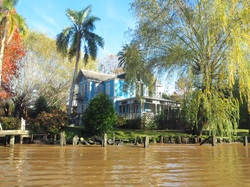 Photo: Just one of the many huge houses with manicured gardens on the Tigre Delta The delta has formed a series of islands that are only accessible by water and have no roads, motorised vehicles or plumbing. While it only takes residents a short boat trip to return to Tigre for supplies such as food and fresh water, it feels like you are a world away from the hustle and bustle of Buenos Aires. The residents on these islands, live right on the edge of the river in some incredible houses built on stilts while the centre of the islands is largely uninhabited due to swampy land and the risk of floods. The islands contain schools, cafes and even a few bungalow-style resort accommodation all built right on the rivers edge. Many of the houses are old colonial style leaving you to wonder how they originally got the resources to build these houses into this area some 100 years ago! We were dropped back into the middle of Buenos Aires after our morning on the river and found ourselves right near one of the city's main attractions, Recoleta Cemetery. I wasn't too fussed about visiting the cemetery, but when we found ourselves right at the front gate, we thought we might as well take a look around. Wade was pretty pumped when we then decided that seeing we now found ourselves in there, we should probably do the obligatory search for Evita's tomb..... yeah i was asking for a fight this time! 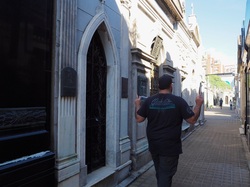 Photo: Wade loving every minute of Recoleta Cemetery. I don't think he even knew I was taking this photo, this was just his general attitude to the experience! We weaved our way through the huge maze of marble clad tombs and crypts without any real plan other than to look for the one with the crowd gathered around it. We found it, we took a photo, and we left, feeling nowhere near as enlightened or satisfied as some of the 20 odd people who were also there draping it with flowers and idols. All in all, Buenos Aires has been a pretty cool city - some say it's the Paris of South America, but Paris doesn't have Evita. We had some good food, walked around pretty much every corner of the city and had some awesome opportunities to practice my super dodgy Spanish! It has been much more expensive than we were originally expecting though, so we are ready to move on..... to the upcoming World Cup. I can only imagine how nice and cheap that will be!! Sadly, today is the day we've been dreading. ANOTHER overnight bus, this time to Puerto Iguazu. Puerto Iguazu will be our base for exploring Iguazu Falls and the point where Argentina, Brazil and Paraguay all meet. While it's only our second overnight bus so far, it is times like these when you start to weigh up the cost benefit of overnight buses rather than flying. While Wade would fly every time, we would probably find ourselves back in Australia much sooner seeing as for every 2 overnight buses we take, we pretty much save enough money to fly the next major leg of our trip. I have been looking forward to seeing the mighty Iguazu Falls for years now, however I think my old mate Mother Nature might be putting a bit of a "dampener" on things: Puerto Iguazú, Misiones Province 7 day Weather Forecast In any case, we are excited to such an incredible natural wonder so my fingers and toes are crossed! If you can spare a few moments please do the same!
|
AuthorEnthusiastic but Useless Traveler. Archives
July 2016
Categories
All
|



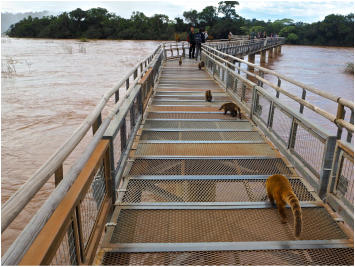




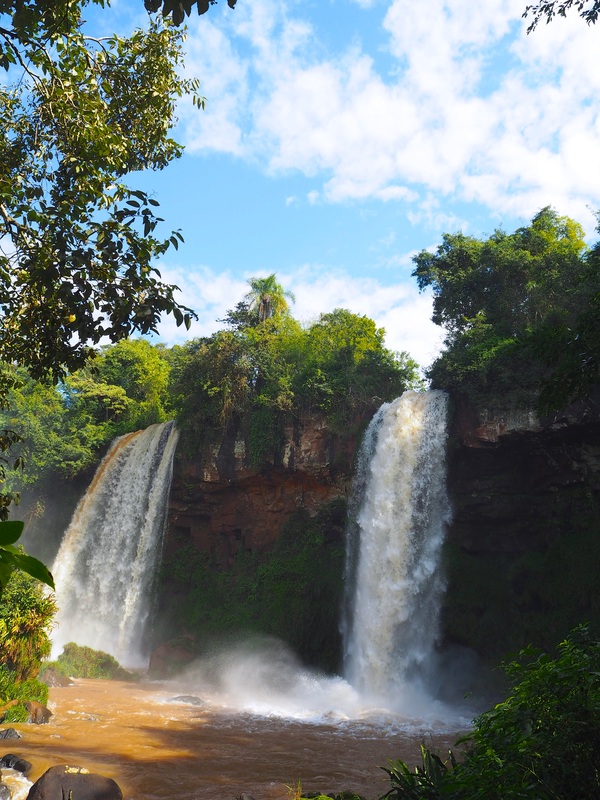
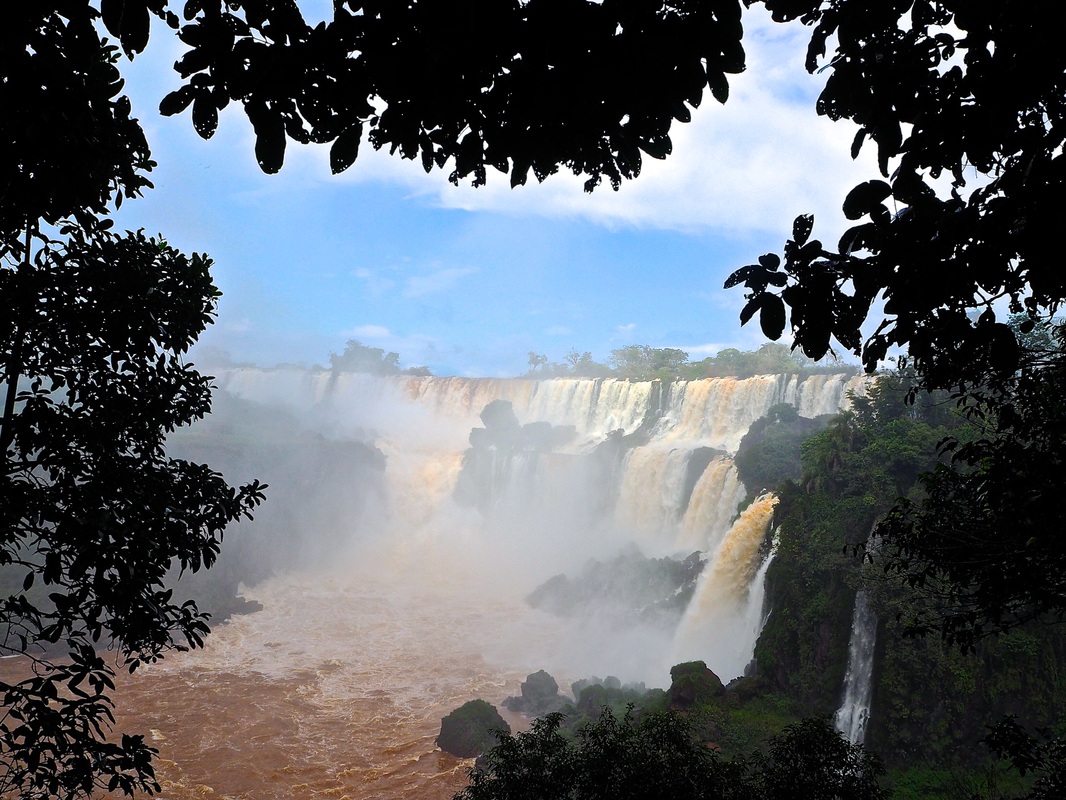
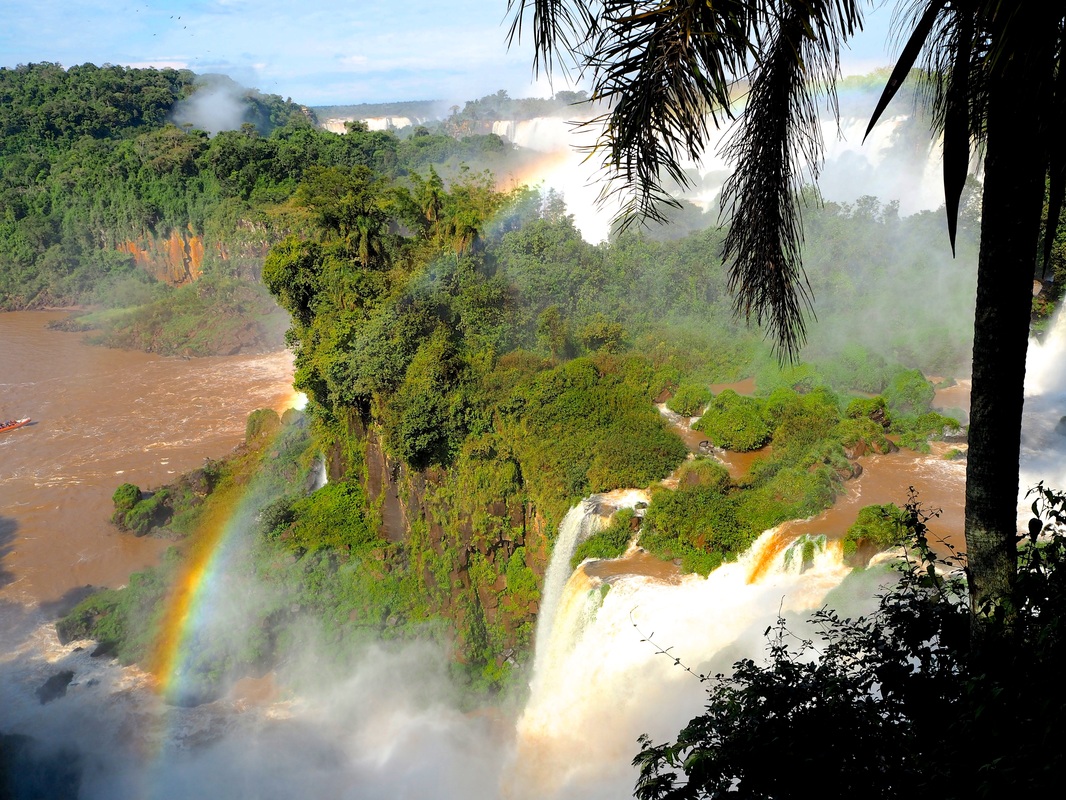

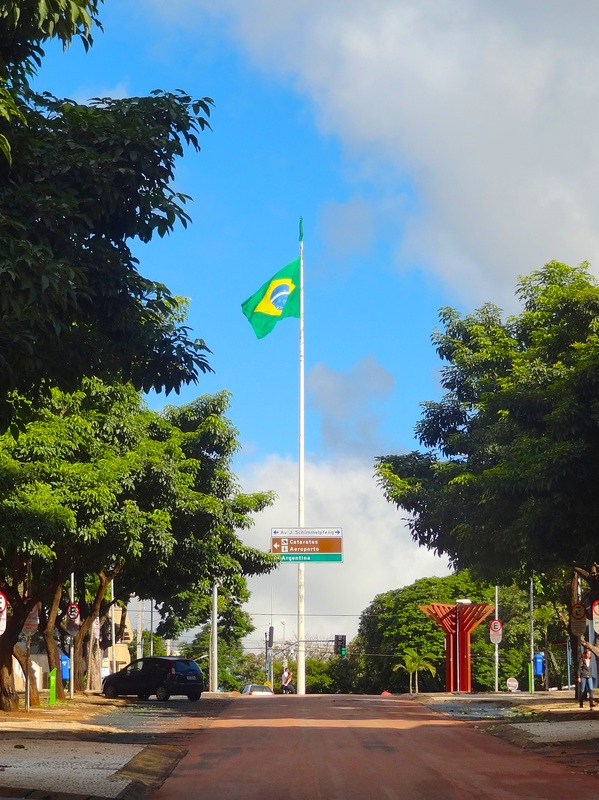

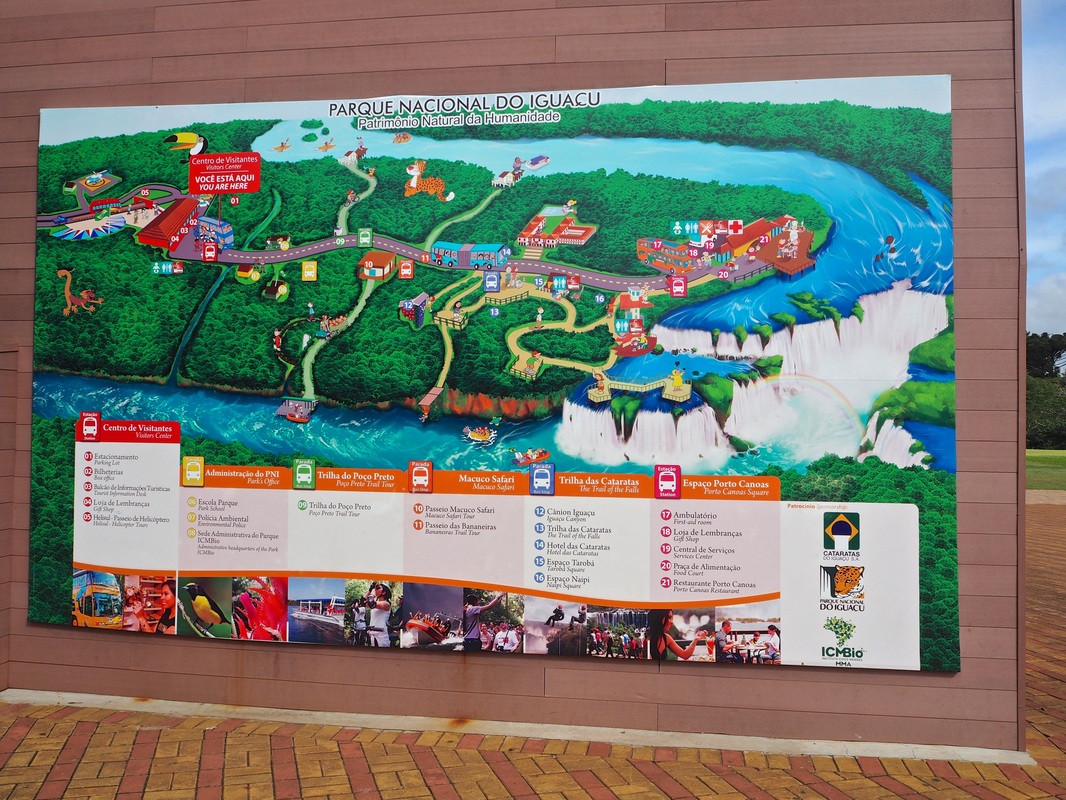

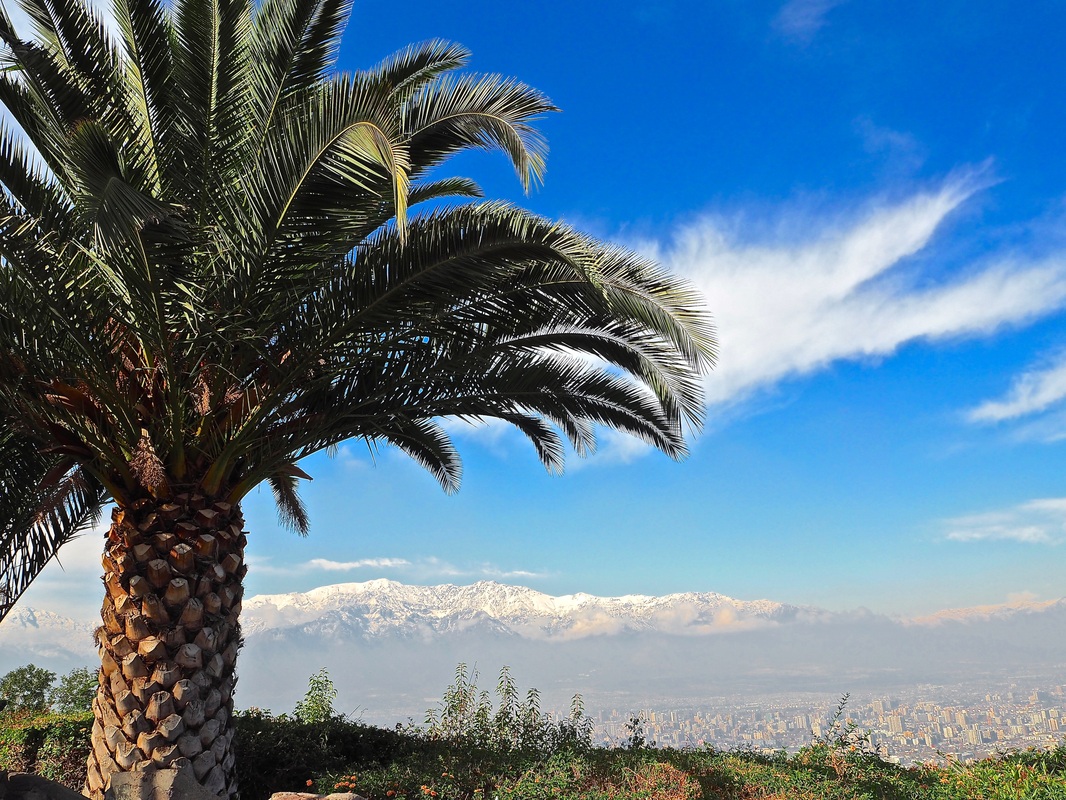



 RSS Feed
RSS Feed